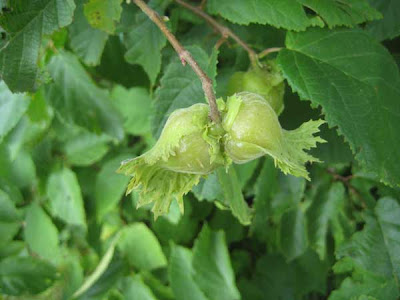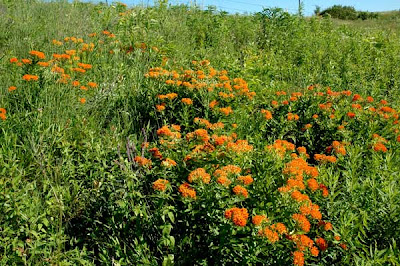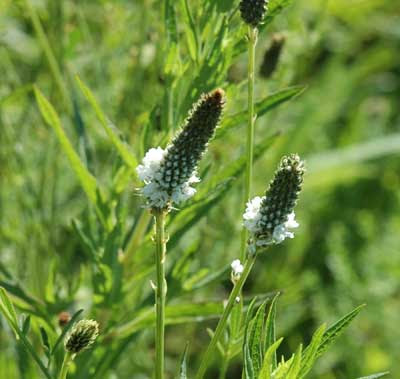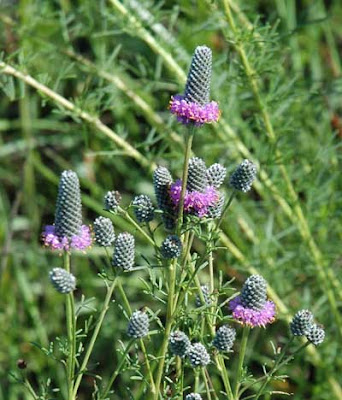Kathie's sweet clover discovery
Sweet clover is generally considered to be a biennial plant. According to most of the scientific literature, the first year it grows only vegetatively, forming relatively small shoots and extensive underground root systems. After a winter cold spell, the plant differentiates one of more vigorous flower stalks, which grow into large plants forming numerous seeds.
Because the first-year plants do not flower, eradication usually focuses on the second year plants. The best approach is to pull the plants up roots and all, which usually works well when the ground is moist and the plant is not too large. If the plant is too large to pull by hand, then its stem can be severed with a sharp shovel below the base, and the severed stem, which contains dormant shoots at the root collar, can be removed.
For the past several years, late in the season (such as now), Kathie and I have been seeing small flowering plants. These plants are often hidden among the lush prairie vegetation that often forms this time of year. What are these plants? Late bloomers? Or first-year plants that have flowered?
As it turns out, both annual and biennial forms of sweet clover exist, and the genetics of this trait was worked out many years ago. (Smith, Hugh Burnice. 1927. Annual versus biennial growth habit and its inheritance in Melilotus alba. American Journal of Botany, Volume 14: 129-146.) The annual form is thought to have originated by mutation from the biennial form. It seems that the biennial form is most frequent in colder regions, suggesting that the biennial condition is an adaptation to overwintering. Annual forms are found in warmer parts of the U.S., such as Mississippi and Alabama.
Smith's research showed that the annual and biennial forms differ by a single gene, and he hypothesized that the annual form was derived from the biennial form by a single mutational event.
 Aware of Smith's work, Kathie and I were interested to see whether some of the
Aware of Smith's work, Kathie and I were interested to see whether some of the  late-flowering sweet clovers mentioned above might be annual forms. Today Kathie made a sweep across the south-facing slope of Pleasant Valley Conservancy (Unit 6) and pulled up by the roots the small flowering plant shown in the photo. Note the very small root system on this plant, quite at variance with the massive root systems found on biennial specimens. Its small size is shown by comparison with the ball-point pen. (See Smith for photographs comparing the annual and biennial forms, and their root systems.)
late-flowering sweet clovers mentioned above might be annual forms. Today Kathie made a sweep across the south-facing slope of Pleasant Valley Conservancy (Unit 6) and pulled up by the roots the small flowering plant shown in the photo. Note the very small root system on this plant, quite at variance with the massive root systems found on biennial specimens. Its small size is shown by comparison with the ball-point pen. (See Smith for photographs comparing the annual and biennial forms, and their root systems.)Despite its small size, this plant has flowered. (See an enlargement of the flower stalk in the photo to the right.) It has also produced seeds on the lower parts of its inflorescence, which have already dropped to the soil. Although only a few seeds may have been produced, these seeds are almost certainly capable of germination.
It seems that there are important implications here for the work on eradicating sweet clover. These tiny plants can easily be missed, especially this time of year, when all the other vegetation is so lush.
Also, our work on sweet clover at Black Earth Rettenmund Prairie (where the infestation has historically been very bad) has shown large numbers of tiny flowering plants in September and October. Previously, we had thought these were resprouts of plants that had not been pulled properly, perhaps broken off at the stem base. Now we are inclined to think that these late-blooming plants might also be annuals.
The hypothesis is that we may be dealing with two kinds of sweet clover plants, the large biennials that have overwintered, and the small annuals that have arisen directly from seeds. For those trying to eradicate sites of sweet clover, this idea may be quite depressing, because it suggests that we need to continue sweet clover work on into the fall, making extensive surveys for the presence of small flowering plants.
We will be interested to learn whether other restoration ecologists in southern Wisconsin have also found evidence of annual flowering plants.


























